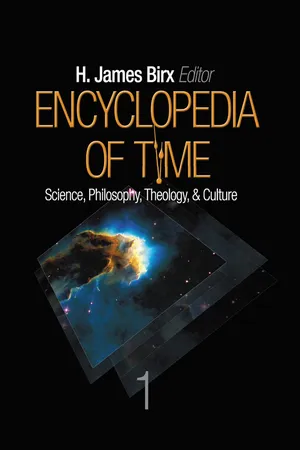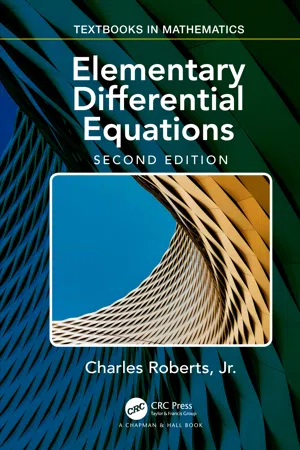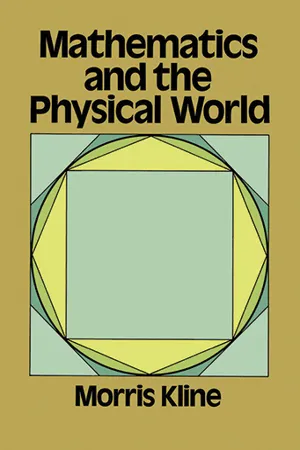Physics
Physical Pendulum
A physical pendulum is a rigid body that can oscillate about an axis due to the force of gravity. Unlike a simple pendulum, which consists of a mass suspended by a string, a physical pendulum has a more complex shape and can exhibit different oscillation behaviors. Its motion is governed by the principles of rotational dynamics and can be analyzed using the moment of inertia and torque.
Written by Perlego with AI-assistance
Related key terms
Related key terms
1 of 4
Related key terms
1 of 3
6 Key excerpts on "Physical Pendulum"
- eBook - ePub
Encyclopedia of Time
Science, Philosophy, Theology, & Culture
- H. James Birx(Author)
- 2009(Publication Date)
- SAGE Publications, Inc(Publisher)
period of the pendulum. This time is constant at a fixed location on earth. It does not depend on the weight of the bob or on the size of the swing (for small swings). It is dependent only on the length of the pendulum. It is this invariant time for one oscillation that makes pendulums useful for regulating the action of several devices, especially clocks. For example, one well-known use of the pendulum is as a metronome to aid musical students to keep time.The motion of the idealized so-called simple pendulum with a light string and frictionless system is referred to as simple harmonic motion, because it is continuous and repetitive, oscillating in such a way that it swings out an equal distance on either side of a central point, with its acceleration toward the central point proportional to the distance of the pendulum from it.The term pendulum is often used outside of timekeeping and science to describe systems or situations where anything undergoes regular shifts or reversals in value, direction, attitude, opinion, or state. For example, one may hear about the “pendulum of public opinion” spinning from one extreme to the next. It is also used to describe systems that use any kind of “to and fro” process. For example, pendulum arbitration is a method of arbitration where one side makes a proposal, and then the other suggests their proposal, with the arbitrator finally choosing one of the proposals, which then becomes binding on both sides. A technique for delivering supplies or for rescue using a helicopter, where a rope or hoist cable is set swinging by rocking the helicopter or pushing and pulling the rope, is called a pendulum maneuver - eBook - ePub
Elementary Differential Equations
Applications, Models, and Computing
- Charles Roberts(Author)
- 2018(Publication Date)
- Chapman and Hall/CRC(Publisher)
10.7. PendulumsIn this section, we will determine critical points for several kinds of pendulums and pendulum systems and study their behavior by examining phase-plane graphs. Since electrical and other mechanical systems give rise to similar systems of differential equations, the results which we obtain here for pendulums will apply to those electrical and mechanical systems also.Simple PendulumA simple pendulum consists of a rigid, straight rod of negligible mass and length ℓ with a bob of mass m attached at one end. The other end of the rod is attached to a fixed support, S , so that the pendulum is free to move in a vertical plane. Let y denote the angle (in radians) which the rod makes with the vertical extending downward from S —an equilibrium position of the system. We arbitrarily choose y to be positive if the rod is to the right of the downward vertical and negative if the rod is to the left of the downward vertical as shown in Figure 10.21.Figure 10.21. Simple Pendulum.We will assume the only forces acting on the pendulum are the force of gravity, a force due to air resistance which is proportional to the angular velocity of the bob, and an external force, f (t ), acting on the pendulum system. Under these assumptions it can be shown by applying Newton’s second law of motion that the position of the pendulum satisfies the initial value problem(1)my ″+ cy ′+ k sin y = f( t ); y( 0 )=c 0,y ′( 0 )=c 1whereLinearized Simple Pendulum with No Damping and No Forcing Functionc ≥ 0is a constant of proportionality,k = m g / ℓ, g is the constant of acceleration due to gravity,c 0is the initial angular displacement of the pendulum from the downward vertical, andc 1is the initial angular velocity of the pendulum.If we assume there is no damping (c = 0) and no forcing function (f ( t ) = 0 - eBook - ePub
Experiments and Demonstrations in Physics
Bar-Ilan Physics Laboratory
- Yaakov Kraftmakher(Author)
- 2014(Publication Date)
- WSPC(Publisher)
et al (2002) observed oscillations of a pendulum with one of three damping effects: friction not depending on the velocity (sliding friction), linear dependence on the velocity (eddy currents in a metal plate), and quadratic dependence on the velocity (air friction).For other experiments with pendulums, see Lapidus (1970); Schery (1976); Hall and Shea (1977); Simon and Riesz (1979); Hall (1981); Yurke (1984); Eckstein and Fekete (1991); Ochoa and Kolp (1997); Peters (1999); Lewowski and Woźniak (2002); LoPresto and Holody (2003); Parwani (2004); Coullet et al (2005); Ng and Ang (2005); Jai and Boisgard (2007); Gintautas and Hübler (2009); Mungan and Lipscombe (2013).Theoretical background. For a mathematical pendulum with friction, the motion equation iswhere m is the mass, a is the acceleration, x is the displacement, v is the velocity, k and λ are coefficients of proportionality, x′ = v = dx/dt, and x″ = d2 x/dt2 . The solution to this equation describing free oscillations iswhere A and φ1 depend on the initial conditions. The natural frequency of the system is ω0 = (k/m)½ = (g/l)½ , the decay of free oscillations is governed by the decay constant δ = λ/2m, and the angular frequency Ω is somewhat lower than ω0 : Ω2 = ω0 2 – δ2 .The transient process after application of a periodic driving force deserves special consideration. Whenever forced oscillations start, a process occurs leading to steady oscillations. This transient process is caused by the superposition of forced and free oscillations. Landau and Lifshitz (1982) and Pippard (1989) considered the problem in detail, and this analysis is partly reproduced here. For a driven mathematical pendulum - eBook - ePub
- Morris Kline(Author)
- 2012(Publication Date)
- Dover Publications(Publisher)
M is the mass of the earth, and r is the distance of the mass being accelerated from the center of the earth. Then the acceleration varies with distance from the center of the earth. Hence, if a pendulum clock is adjusted so that it beats seconds at one location, it will not be accurate at another location if the acceleration due to gravity is different there. The pendulum clock may have to be readjusted if it is moved from one location to another.It is an ill wind, however, that blows no good. The fact that the period of the pendulum depends upon the acceleration due to gravity was turned to excellent advantage by seventeenth- and eighteenth-century mathematicians and scientists. To follow their work let us first rewrite formula (16). In our derivation of this result we used 32 for the acceleration due to gravity. Let us now reconsider the derivation with the quantity 32 replaced by the symbol g, which is the customary symbol for the acceleration due to the direct action of gravity, as opposed to the symbol a, which is used for any acceleration, whether due to gravity or some other force. Then the derivation would continue to hold as long as g is constant, which it is in any one location, and formula (16) would read(17)Now suppose that by adjusting l, the period T of a pendulum is made to be one second at a location where g is, say, 32. If the pendulum is moved to another location and if the period is now measured, then formula (17) may be used to calculate g. Hence the acceleration due to gravity can be measured at a variety of locations. This method is very accurate and is used today for precise determinations of g.As the pendulum is moved from either pole toward the equator it is found that g decreases from the value of 32.257 ft/sec2 at the poles to 32.089 ft/sec2 at the equator. This difference, small as it may seem, must be explained.Newton had considered the shape of the earth. On the assumption that it was homogeneous throughout, that is, it possessed the same density all the way down to the center, and that it was subject to the attraction of the sun and to rotation, he proved that the earth’s shape is not a sphere but an ellipsoid of revolution, roughly a sphere flattened somewhat at the top and bottom. Hence an object on the surface of the earth is farthest from the center at the equator and closest to the center at the poles. Since r, the distance from the center of the earth, decreases the closer one is to the poles, the greater g must be as one moves from the equator to either pole. Thus far at least the argument agrees with the measured values of g. However, according to the calculations of Newton and Huygens and the more accurate later calculations of the mathematician Clairaut, the flattening of the earth at the poles is not sufficient to account for the observed variation in g; that is, the distance from the center of the earth to either pole is not sufficiently less than the distance to the equator to account for the larger value of g - eBook - ePub
- Sir James H. Jeans(Author)
- 2013(Publication Date)
- Dover Publications(Publisher)
.216. This motion is realized experimentally in the motion of a pendulum which is not constrained to move in one vertical plane, but of which the deviations from the vertical remain small.FIG. 134Let the pendulum be of length a, and let its bob be displaced from its equilibrium position 0 to some near point P, such that the angle PCO may be treated as small. Calling this angle θ , the weight of the bob may be resolved into mg cos θ along CP, which is exactly neutralized by the tension of the string, and a force mg sin θ along PO. If θ is small, sin θ may be put equal to θ , and this in turn to . Thus the bob may be supposed to experience a force OP along OP. The motion is therefore of the kind a which has been described, the value of μ being , and the value . of p therefore being Thus we see that a hanging weight drawn from its position of equilibrium and projected in any way will always describe an ellipse in the horizontal plane in which it is free to move, having the point immediately below its point of suspension as center.An arrangement may sometimes be seen at village fairs in England, in which the showman ingeniously takes advantage of this result. A weight is suspended by a string, and a skittle is placed on the floor exactly under the point of suspension of the weight. Passers-by are invited to pay an entrance fee and compete for a prize which is awarded to any one who can project the weight so that on its return it knocks the skittle over. The problem is, of course, as impossible as that of describing an ellipse which shall pass through its own center. - eBook - ePub
Science Teaching
The Contribution of History and Philosophy of Science, 20th Anniversary Revised and Expanded Edition
- Michael R. Matthews(Author)
- 2014(Publication Date)
- Routledge(Publisher)
It remains to be seen how the pendulum will feature in the final NGSS document, but the signs are not good. In the current (2012) draft, the pendulum is mentioned four times, and each time it is in connection with the transformation of energy from potential to kinetic forms. This is a level of abstraction way beyond what is needed or called for, it is beyond the life experience of the students and it reifies the role played by the pendulum in the history of physics and in its social utilisation. The draft document mentions Newton’s laws, his theory of gravitation and the conservation of momentum, but no mention of the pendulum, which could so easily be used to make manifest and experiential each of these learning goals.ConclusionThe pendulum case has been introduced in this chapter as an example where the HPS can contribute to even routine science education. It provides an opportunity to learn about science at the same time as one is learning the subject matter of science. With good HPS-informed teaching the pendulum-motion case enables students to appreciate the transition from common-sense and empirical descriptions characteristic of Aristotelian science, to the abstract, idealised and mathematical descriptions characteristic of the scientific revolution. The pendulum provides a manageable, understandable and straightforward way into scientific thinking and away from everyday and empirical thinking; it shows, at the same time, how scientific, idealised thinking nevertheless is connected with the world through controlled experiment.The ‘contextual’ teaching of science, as suggested here, is not a retreat from serious, or hard, science, but the reverse. To understand what happened in the history of science takes effort. Further, it is appealing to students. A frequent refrain from intelligent students who do not go on with study in the sciences is that, ‘science is too boring; we only work out problems’.37
Index pages curate the most relevant extracts from our library of academic textbooks. They’ve been created using an in-house natural language model (NLM), each adding context and meaning to key research topics.
Explore more topic indexes
Explore more topic indexes
1 of 6
Explore more topic indexes
1 of 4





